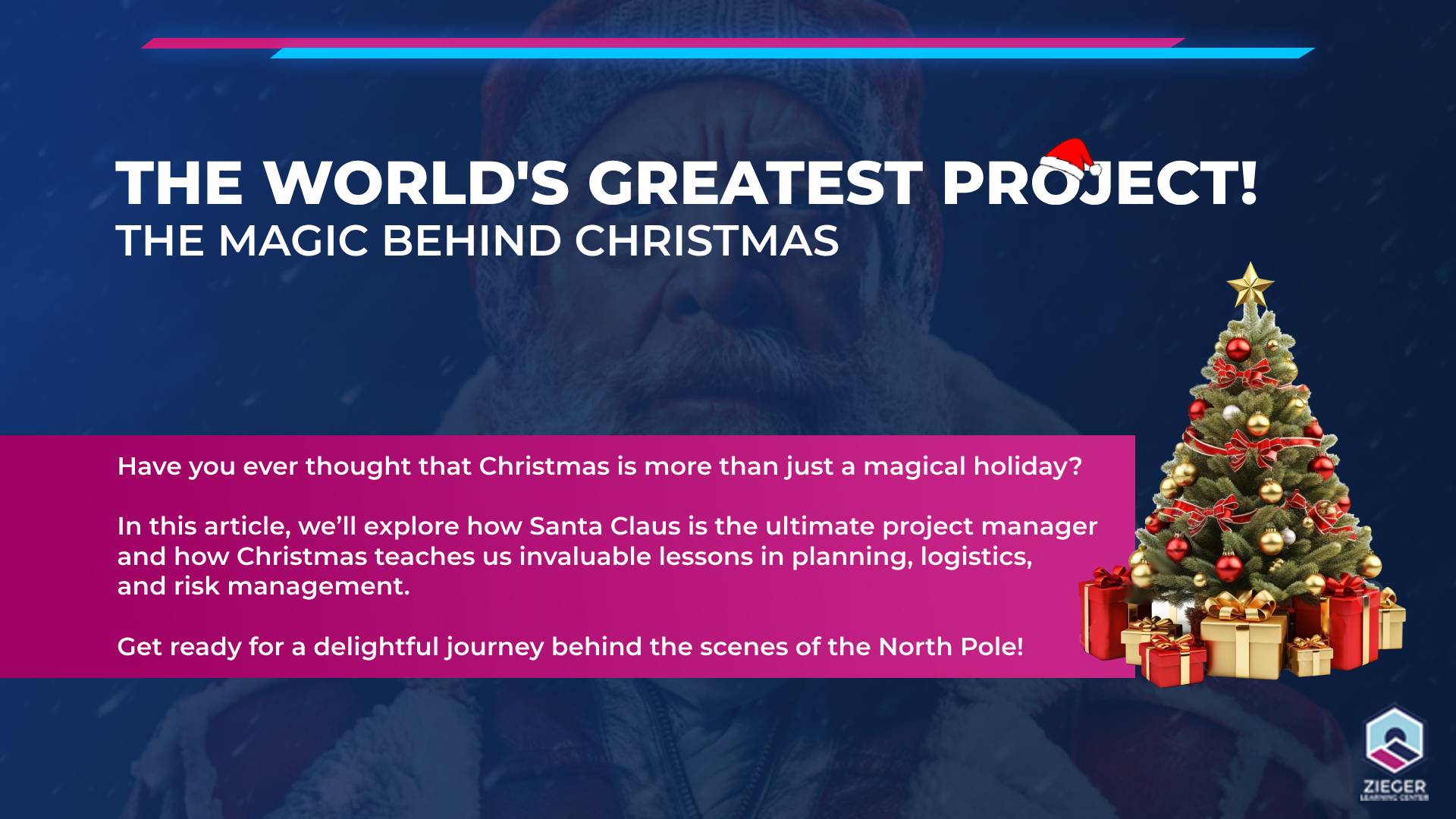The World’s Greatest Project: The Magic Behind Christmas

Introduction: The Magic of the World’s Largest Project
Every year-end, we are overtaken by a unique sensation. It’s as if the whole world, regardless of culture or location, breathes a little more hope. Streets become brighter, children’s smiles grow more contagious, and even the most skeptical seem to slow down just to savor the moment. That’s the magic of Christmas.
But behind all this celebration, there’s something we rarely consider: what if Christmas were, in fact, a gigantic project? A project that, for centuries, has been carried out flawlessly, delivering results that enchant billions of people. And what if the magic, which we so often attribute to Santa Claus, were also the result of meticulous, strategic, and planned work?
Santa Claus, besides being the ultimate symbol of the Christmas spirit, could very well be seen as the greatest project manager in history. Think about it: he has to fulfill millions—perhaps billions—of requests, handle countless deadlines, coordinate a multidisciplinary team of elves, manage the most complex logistics ever conceived, and, to top it all off, achieve it all without losing the magical touch that makes Christmas what it is.
If you’ve ever led a project (even if it was organizing a last-minute Secret Santa), you know how challenging it can be. Now imagine doing that on a global scale. It’s almost impossible to imagine, isn’t it? Almost… because Santa Claus and his team at the North Pole make it look easy, year after year.
And this is exactly the story we want to tell. Not about Christmas as we know it, but about Christmas as the world’s largest project—with clear objectives, complex stakeholders, and an absolutely non-negotiable deadline: December 25th.
The Project Scope: Making Magic Real
Behind every delivered gift and every illuminated Christmas tree lies a greater goal: to ensure that the Christmas spirit reaches every home in the world, bringing joy, unity, and, of course, presents for children. But turning an ideal into action requires a well-defined plan. And Santa Claus, a master of management, knows this better than anyone.
The project scope is clear and immutable:
- Deliver personalized gifts to all the children in the world who behaved well throughout the year.
- Ensure that all deliveries are made between the evening of December 24th and the early hours of December 25th.
- Maintain absolute secrecy during the operation. No child can see Santa in action!
The simplicity of the scope conceals the complexity of the work. After all, to achieve this goal, it’s necessary to address a multitude of challenges:
- Mapping children worldwide and maintaining a constantly updated list, including specific wishes.
- Producing or acquiring the gifts, ensuring each request is fulfilled with precision.
- Planning an efficient route to circle the planet in just a few hours, considering time zones, weather conditions, and, of course, the reindeer.
- Coordinating entry into homes, which requires parents’ collaboration or the strategic application of magic.
And all of this needs to be done without room for error. There’s no space for delays, production failures, or packages delivered to the wrong address. Santa knows that the success of the project depends on a well-defined scope and flawless execution. After all, we’re not just talking about presents; we’re talking about nurturing dreams and keeping the magic of Christmas alive.
Stakeholders: A Global Network of Collaboration
Every great project depends on its stakeholders, and in the case of Christmas, Santa Claus needs to coordinate a global network of stakeholders that, in terms of diversity and complexity, makes any multinational corporation seem small. Each one plays an essential role in the success of this massive operation. Let’s meet the main ones:
1. The Children: The End Customers
The children are the soul of the project. They not only define the objectives (their gift requests) but also impose strict criteria: the magic of Christmas only happens if their dreams are fulfilled. They send detailed letters, sometimes with unusual wishes, and anxiously await the night of the 24th.
But they are demanding and often unpredictable clients. They change their minds about gifts at the last minute, move to a new address without notifying anyone, and keep Santa and his team constantly adapting their planning. To manage this, Santa relies on a highly sophisticated list—the famous “naughty and nice list”—which undergoes constant audits to ensure accuracy.
2. The Parents: The Facilitators
Although they are not the primary focus, parents play an essential role. They help Santa plan entry into homes, leaving doors unlocked or a window conveniently open. They are also responsible for sustaining the magical narrative, encouraging children to write letters and behave well throughout the year.
Additionally, parents often act as “backups” for the project. In emergency cases, such as last-minute requests or toys the sleigh couldn’t deliver, they ensure children’s expectations are met. It’s a silent yet crucial collaboration.
3. The Elves: The Operational Team
The elves are the heart of the operation. They not only manufacture toys at the North Pole but also manage all quality control and the sleigh’s logistics. Each elf has a specialty: assembly, painting, packaging, or even sleigh maintenance.
Santa’s leadership is essential to keeping the morale of this team high. After all, manufacturing billions of presents is no easy task, and maintaining motivation requires more than inspiring speeches: it demands the magic of purpose.
4. The Reindeer: The Front Line
When it comes to delivery, the reindeer are the elite team. More than just a mode of transportation, they are responsible for braving snowstorms, crossing oceans, and flying through time zones without missing a beat.
Training begins early in the year, with Rudolph leading the sessions. After all, speed and precision are crucial to completing the mission. To ensure performance, Santa invests in special nutrition, magical physiotherapy, and a rigorous training schedule.
5. Suppliers and Partners
Not all toys are made at the North Pole. Many come from partner manufacturers around the world, who must adhere to the quality and punctuality standards set by Santa’s team. These suppliers work closely with the elves, ensuring everything is ready for the big night.
Project Planning: A Never-Ending Cycle
Santa may rest on December 26th, but Christmas is a continuous project. His team works year-round to ensure everything is ready when the time comes. Christmas planning follows a meticulous schedule, refined over the centuries to ensure maximum efficiency.
Stage 1: January to March – Performance Analysis
Right after Christmas, the team gathers to evaluate the previous year’s performance.
- What went well? On-time deliveries, new sleigh technologies, reindeer exceeding expectations.
- What could improve? Incorrect addresses, defective toys, or routes that could be optimized.
This analysis results in a detailed lessons-learned report, which is used to guide the planning of the next cycle.
Stage 2: April to July – Strategic Planning
Based on the report, the strategic planning phase begins. Here, Santa and his team set the year’s priorities:
- Adjusting the children’s list based on new data.
- Renewing contracts with suppliers and expanding partnerships if necessary.
- Investing in new technologies for the sleigh, reindeer, or even data management.
During this period, the reindeer also begin their training to ensure they are in peak form by December.
Stage 3: August to November – Production and Testing
This is the most intense period at the North Pole. Elf factories operate in near-continuous shifts, ensuring every toy is produced and tested. Santa personally oversees the operations, ensuring everything meets the highest standards.
In addition, the team conducts simulations of Christmas Eve, testing the sleigh’s route, the reindeer’s endurance, and even the magical mechanisms that allow presents to be delivered to homes without chimneys.
Stage 4: December – Final Execution
Finally, December arrives. The North Pole transforms into a last-minute headquarters. The elves conduct final checks, Santa reviews the list one last time, and the reindeer rest up for the big night. Everything must be perfect, as there’s no room for error.
On the 24th, Santa departs with his sleigh, equipped with the latest magical technology, and embarks on the mission the entire world awaits: bringing joy to every home.
Logistics and Resource Management: The Sleigh, the Reindeer, and the Engineering of Christmas
The logistics of Christmas are, without exaggeration, one of the most complex operations in history. Delivering presents to billions of children in a single night is a challenge that combines precision, planning, and a touch of magic. But how does Santa manage to orchestrate this feat year after year? The answer lies in carefully designed logistics and the efficient use of resources.
The Sleigh: Cutting-Edge Technology and Innovative Design
Santa’s sleigh is the centerpiece of the entire operation. It is not just a simple mode of transportation but a true technological marvel. With the capacity to carry billions of presents without ever appearing full, it operates with a magical compression system that adjusts the volume of each package. This ensures maximum efficiency and allows the sleigh to remain agile throughout the night.
Additionally, the sleigh is equipped with a magical GPS system that maps every house in the world, updating routes in real time to avoid obstacles such as storms or tricky time zones. There are even rumors that it uses a blockchain-like system to prevent duplicate deliveries, ensuring every gift reaches its correct destination.
Additionally, the sleigh is equipped with a magical GPS
The sleigh is equipped with a magical GPS that maps every house in the world, updating routes in real-time to avoid setbacks like storms or complicated time zones. Rumor has it that it also uses a blockchain-like system to prevent delivery duplication, ensuring every present reaches its correct destination.
The Reindeer: The World’s Most Famous Transportation Team
The sleigh, impressive as it is, would be nothing without the reindeer. Led by Rudolph, they are the ultimate example of teamwork. Each reindeer is responsible for a part of the effort, alternating between strength and speed to maintain a constant flight rhythm.
But this performance doesn’t happen by chance. Throughout the year, the reindeer undergo rigorous training that includes flight simulators, resistance to extreme cold, and even evasive maneuvers to avoid air radar. Additionally, Santa ensures that they are all well-fed with a diet rich in magical carrots, essential for the shine and strength that make them unique.
The Distribution Centers at the North Pole
Although the North Pole is the heart of the operation, Santa understands the importance of decentralization. To ensure everything runs smoothly, he uses strategically placed magical distribution centers around the globe. These centers allow the sleigh to replenish its cargo of gifts and optimize the routes, reducing delivery times.
This logistical infrastructure is a brilliant example of how to manage resources to meet tight deadlines and global demands.
Risk Management: Prepared for the Impossible
No project is immune to risks, and Christmas is no exception. Santa and his team face unique challenges that could compromise the entire operation, but their experience and preparation ensure that each risk is managed with care.
Identified Risks and Mitigation Strategies
- Wrong Addresses or Children Who Moved
- Mitigation: Use of a real-time magical tracking system, which cross-references last-minute information to ensure accuracy. Additionally, the IT elves work extra shifts to keep the list updated.
- Severe Weather Conditions
- Mitigation: The reindeer are trained to fly in any condition, and the sleigh is equipped with a weather shield that protects it from snowstorms, rain, or strong winds.
- Supplier Issues
- Mitigation: Santa works only with trusted partners but keeps emergency stock at the North Pole to cover delays.
- Lack of Elf Motivation
- Mitigation: Seasonal parties and a magical work culture ensure that everyone is happy and engaged.
- Reindeer Health Problems
- Mitigation: Magical veterinarians and a reserve system of reindeer ensure no surprises on the big night.
Lessons for the Corporate World
Santa’s risk management teaches us the importance of predicting problems before they happen and creating robust solutions. In the business world, a good mitigation plan can be the difference between the success and failure of a project.
Execution: The Big Night
Finally, the most anticipated night of the year arrives. It’s the moment of truth, the time when months of planning, preparation, and training are put to the test. At midnight on December 24th, Santa climbs into his sleigh, the reindeer take their positions, and the magic happens.
Checklists and Synchronization
Before departing, Santa and his team perform a series of checks:
- Are the presents properly organized in the sleigh? Each package needs to be in the exact order of delivery to avoid delays.
- Are the reindeer in peak condition? Rudolph leads the team with his bright nose, ensuring visibility in any weather condition.
- Has the route been adjusted? The magical GPS system reviews the route one last time, adjusting for time zones and unexpected optimizations.
The Delivery: Precision and Magic
Santa begins his journey, crossing the sky with impressive speed and precision. Each house visited is another mission accomplished. He enters discreetly, leaves the presents under the tree, and moves on to the next destination, all without being seen.
Meanwhile, his team at the North Pole monitors the operation in real time, ready to intervene if anything goes off course. It’s a true masterpiece of logistical execution and leadership.
Evaluation and Lessons Learned: Preparing for Next Christmas
As soon as the last present is delivered and the sun rises on December 25th, Santa returns to the North Pole. But the work doesn’t stop there. Like any good project manager, he knows that performance evaluation is essential for improving in the future.
Feedback and Metrics
- Customer Satisfaction: The thank-you letters from children and feedback from parents are analyzed to measure the success of the project.
- Operational Efficiency: The average delivery time, reindeer performance, and route accuracy are reviewed.
- Problems Encountered: From damaged toys to unexpected delays, every detail is recorded to ensure it doesn’t happen the next year.
Planning for the Future
Based on this evaluation, Santa and his team begin planning for the following Christmas. After all, a successful project doesn’t end with the delivery; it keeps evolving, year after year.
Conclusion: Christmas as Inspiration
Christmas, with all its magic and enchantment, is much more than a holiday. It’s a shining example of how to plan, execute, and lead a project with excellence. Santa, with his dedicated team, shows us that even the most ambitious goals can be achieved with organization, collaboration, and a touch of magic.
As we celebrate this season, perhaps we can carry these lessons into our own lives and careers. After all, if Santa can serve billions of children in a single night, what’s stopping us from realizing our own dreams and completing our projects?
Merry Christmas!


